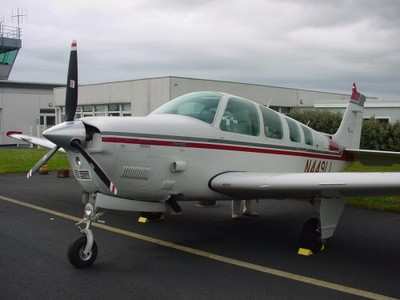Ensuing Accident During Missed Approach Resulted In The Pilot's Fatal Injury
The NTSB has released a probable cause report from an accident that occurred last November 11th in which a non-instrument-rated private pilot filed an instrument flight plan to an airport that was reporting night instrument meteorological conditions (IMC).

The flight did not end well. The pilot was fatally injured when the he lost control of the airplane ... a Beechcraft B36TC Bonanza (N4245D) ... during an attempted missed approach. The airplane impacted terrain about 2 nautical miles northeast of the Rick Husband Amarillo International Airport (KAMA), Amarillo, Texas.
Air traffic control radar and communications data indicated that the pilot flew three previous flights on Sunday, November 10, 2013, before the accident flight. The first flight departed Tradewind Airport (KTDW), Amarillo, Texas, about 1424 and landed at KLBB about 1502. The second flight departed KLBB about 1536 and landed at the Collin County Regional Airport (KTKI), Dallas, Texas, about 1716. The third flight departed KTKI about 2123 and landed at KLBB about 2317. The accident flight departed KLBB about 2347 with KTDW as the intended destination. IFR flight plans were filed for all four flights.
Amarillo was reporting ¼-mile visibility, fog, sky obscuration, and 100-foot vertical visibility. Radar track data showed that, upon arrival at the airport, the pilot flew the instrument lighting system approach and then attempted to execute a missed approach. During the missed approach, radar contact was lost and the airplane went down. The postaccident examination of the airframe and engine revealed no evidence of mechanical malfunctions or failures that would have precluded normal operation.
The 48-year-old private pilot held a single-engine airplane land rating which he received on July 16, 1985. He held a third class medical certificate issued on October 24, 2013. During his medical examination, the pilot reported that his total flight time was 410 hours. There was no FAA record of an instrument rating being issued to the pilot.
On October 24, 2014, the pilot took the FAA instrument knowledge test that is required to get an instrument rating. However, he received a score of 68 percent on the test, and a passing score is 70 percent. The pilot intended to fly the instrument check ride, but was unable to take the instrument check ride until he passed the instrument knowledge test.

According to the NTSB probable cause report, the pilot purchased the accident airplane on October 30, 2013, in Greensboro, North Carolina. The airplane broker who sold the pilot the airplane reported that the pilot intended to have his instrument rating completed prior to purchasing the airplane. The pilot received two days of initial Bonanza training after he purchased the airplane. The initial training consisted of 4 hours of ground instruction followed by 10.5 hours of flight instruction. The flight instructor reported that the pilot had about 400 to 600 hours of flight time in a Cessna 172RG. The pilot did not have any experience with the flight director, autopilot, or the Garmin Nav/Coms. The flight instructor reported they practiced basic air work which included takeoff and landings, stalls, steep turns, unusual attitudes, and emergency procedures. About 2.5 hours of flight time was flown in IMC conditions in which they practiced using the autopilot and flight director, programing the Garmin for
instrument approaches, and hand flying in IMC conditions. As a result of the initial Bonanza training, the pilot received a high performance endorsement and a complex airplane endorsement.
The pilot’s toxicology report indicated that gabapentin and duloxetine were found in the pilot’s system, and both are disqualifying drugs for flight. The pilot did not report either of these disqualifying medications on his last medical certification examination. While both medications are sedating, a witness reported that the pilot was alert and energetic before the flight and showed no signs of sedation. Witness reports and findings from the wreckage examination are consistent with a loss of control event, and, based on the degraded visual reference conditions present about the time of the accident, it is likely that the pilot experienced spatial disorientation. Although it could not be determined what effect the use of the medications had on the pilot’s performance during the high-workload IMC flight, their use could increase the chance of experiencing and responding inappropriately to spatial disorientation.
The NTSB determined that the probable cause(s) of this accident to be the non-instrument-rated pilot’s improper decision to fly a night instrument approach in instrument meteorological conditions, which resulted in the pilot’s spatial disorientation and loss of control of the airplane during an attempted missed approach.
(Image from file. Not accident airplane)
 Airborne 04.16.24: RV Update, Affordable Flying Expo, Diamond Lil
Airborne 04.16.24: RV Update, Affordable Flying Expo, Diamond Lil ANN's Daily Aero-Term (04.20.24): Light Gun
ANN's Daily Aero-Term (04.20.24): Light Gun Aero-News: Quote of the Day (04.20.24)
Aero-News: Quote of the Day (04.20.24) Aero-News: Quote of the Day (04.21.24)
Aero-News: Quote of the Day (04.21.24) ANN's Daily Aero-Term (04.21.24): Aircraft Conflict
ANN's Daily Aero-Term (04.21.24): Aircraft Conflict




